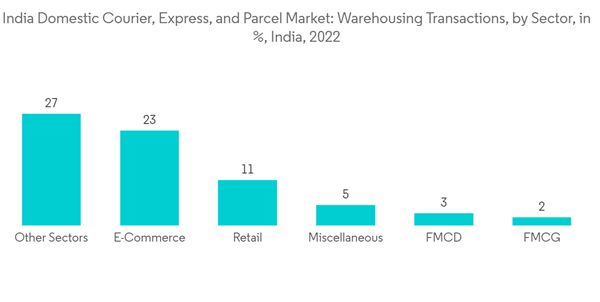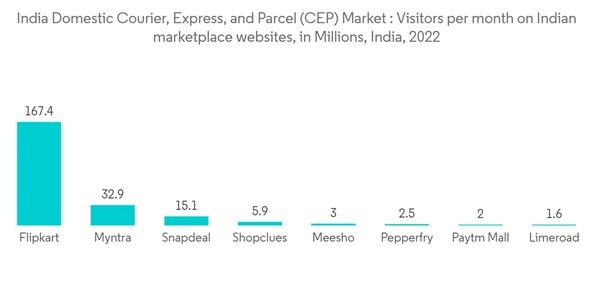The Indian domestic courier, express, and parcel (CEP) market is estimated to register a CAGR of more than 15% during the forecast period. The increasing consumer preference for shopping online through various e-commerce portals also boosts the market growth.
With over 800 Direct-to-Consumer (D2C) brands in the country, the sector is expected to grow to USD 100 billion by 2025. Due to its broad consumer reach and greater engagement, the D2C business model was adopted by various brands and merchants in 2021. As the D2C industry grows, more D2C brands are looking for platforms that provide end-to-end logistics and fulfillment services, and this trend is expected to continue in the years ahead.
One of the elements of a thriving logistics ecosystem is robust warehousing. To ensure flawless warehouse management, logistics players have begun automating practically every component to ensure human resources are committed to the more critical, challenging jobs. Even though pre-pandemic years saw digital integration in warehouses, 2021 has proven to be a year of progress. Logistics systems have incorporated robotic order picking and even packaging to reduce time and money, and today, warehouses.
Because of the pandemic, consumers increasingly prefer contactless services for nearly every purchase. The logistics industry offers contactless deliveries that customers can verify with an OTP sent to their phones. Such contactless services have gained so much traction that they will likely become industry standards.
These remarkable numbers are attributed partly to the global pandemic, which has caused many people to prefer to shop online rather than leave their homes. One explanation for India's phenomenal rise in the online shopping sector is the increasing penetration of IT infrastructure and mobile phone and internet connectivity in rural areas. Aside from that, new government laws now encourage 100% foreign direct investment in B2B e-commerce enterprises, which has aided the Indian internet market's growth.
According to forecasts, the online grocery industry, valued at roughly USD 2 billion in 2021, will grow to USD 29 billion by 2024. This is because, as a result of reputable companies joining the market, more individuals purchase groceries online.
Experts predict that the number of online shoppers in India will exceed 350 million in the next five years. This alone will help India's e-commerce business grow, as more customers equal more money made through e-commerce transactions.
This product will be delivered within 2 business days.
Key Highlights
- The COVID-19 pandemic impacted every sector. However, the pandemic accelerated online purchasing, positively impacting the domestic CEP industry's growth and increasing its market share. E-commerce stores in India were collaborating with courier service providers to deliver their products across domestic locations. Additionally, technological advancements, including using digital technologies with crowdsourced delivery models, created a positive outlook for the market in India. The growing e-commerce sector, along with the growing cross-border trade, was one of the key factors driving the growth of the domestic CEP market. The domestic CEP market was expected to grow and hold a significant share during the forecast period, driven by the B2C e-commerce boom.
- India has been becoming a significant domestic shipment market, with significant companies entering and expanding networks in the market. Innovation has become critical for organizations to consider market trends and dynamics seriously. Digitizing the economy and providing cheap internet to people are a few reasons that boosted digital sales growth in India.
India Domestic Courier, Express, and Parcel (CEP) Market Trends
New Innovations and Technology Driving the Market
Consumer preferences constantly change, so they demand a more personalized e-commerce and logistics experience that pampers them and provides the most excellent ease from beginning to end. To meet this increased demand, logistics platforms employ technologies like AI, IoT, and Big Data to gain insights into consumer preferences and adapt their experiences.With over 800 Direct-to-Consumer (D2C) brands in the country, the sector is expected to grow to USD 100 billion by 2025. Due to its broad consumer reach and greater engagement, the D2C business model was adopted by various brands and merchants in 2021. As the D2C industry grows, more D2C brands are looking for platforms that provide end-to-end logistics and fulfillment services, and this trend is expected to continue in the years ahead.
One of the elements of a thriving logistics ecosystem is robust warehousing. To ensure flawless warehouse management, logistics players have begun automating practically every component to ensure human resources are committed to the more critical, challenging jobs. Even though pre-pandemic years saw digital integration in warehouses, 2021 has proven to be a year of progress. Logistics systems have incorporated robotic order picking and even packaging to reduce time and money, and today, warehouses.
Because of the pandemic, consumers increasingly prefer contactless services for nearly every purchase. The logistics industry offers contactless deliveries that customers can verify with an OTP sent to their phones. Such contactless services have gained so much traction that they will likely become industry standards.
Rise in the E-commerce Sector to Boost the Domestic CEP Market in India
India's e-commerce expansion will also help the country become a key player in e-business, with a projected growth potential of just under USD 100 billion by 2024. Fashion, apparel, and groceries are the top-performing categories in India's e-commerce market share. Consumer electronics, projected to increase at an annual rate of up to 8% by 2025, closely follows these sectors.These remarkable numbers are attributed partly to the global pandemic, which has caused many people to prefer to shop online rather than leave their homes. One explanation for India's phenomenal rise in the online shopping sector is the increasing penetration of IT infrastructure and mobile phone and internet connectivity in rural areas. Aside from that, new government laws now encourage 100% foreign direct investment in B2B e-commerce enterprises, which has aided the Indian internet market's growth.
According to forecasts, the online grocery industry, valued at roughly USD 2 billion in 2021, will grow to USD 29 billion by 2024. This is because, as a result of reputable companies joining the market, more individuals purchase groceries online.
Experts predict that the number of online shoppers in India will exceed 350 million in the next five years. This alone will help India's e-commerce business grow, as more customers equal more money made through e-commerce transactions.
India Domestic Courier, Express, and Parcel (CEP) Industry Overview
The report covers the major players operating in the Indian domestic CEP Industry. The market is fragmented, with many local and international players. The market is expected to grow during the forecast period. The major players, such as Instakart Services Private Limited, Blue Dart Express Limited, DHL Express (India) Private Limited, Delhivery Private Limited, and FedEx Express, contribute significantly to the market's growth.Additional Benefits:
- The market estimate (ME) sheet in Excel format
- 3 months of analyst support
This product will be delivered within 2 business days.
Table of Contents
1 INTRODUCTION
2 RESEARCH METHODOLOGY
4 MARKET INSIGHTS
5 MARKET DYNAMICS
6 MARKET SEGMENTATION
7 COMPETITIVE LANDSCAPE
Companies Mentioned (Partial List)
A selection of companies mentioned in this report includes, but is not limited to:
- Instakart Services Private Limited
- Blue Dart Express Limited
- DHL Express (India) Private Limited
- Delhivery Private Limited
- FedEx Express
- Safexpress Private Limited
- DTDC Express Limited
- Ecom Express Private Limited
- Gati-Kintetsu Express Private Limited
- UPS Express Private Limited*
Methodology

LOADING...










